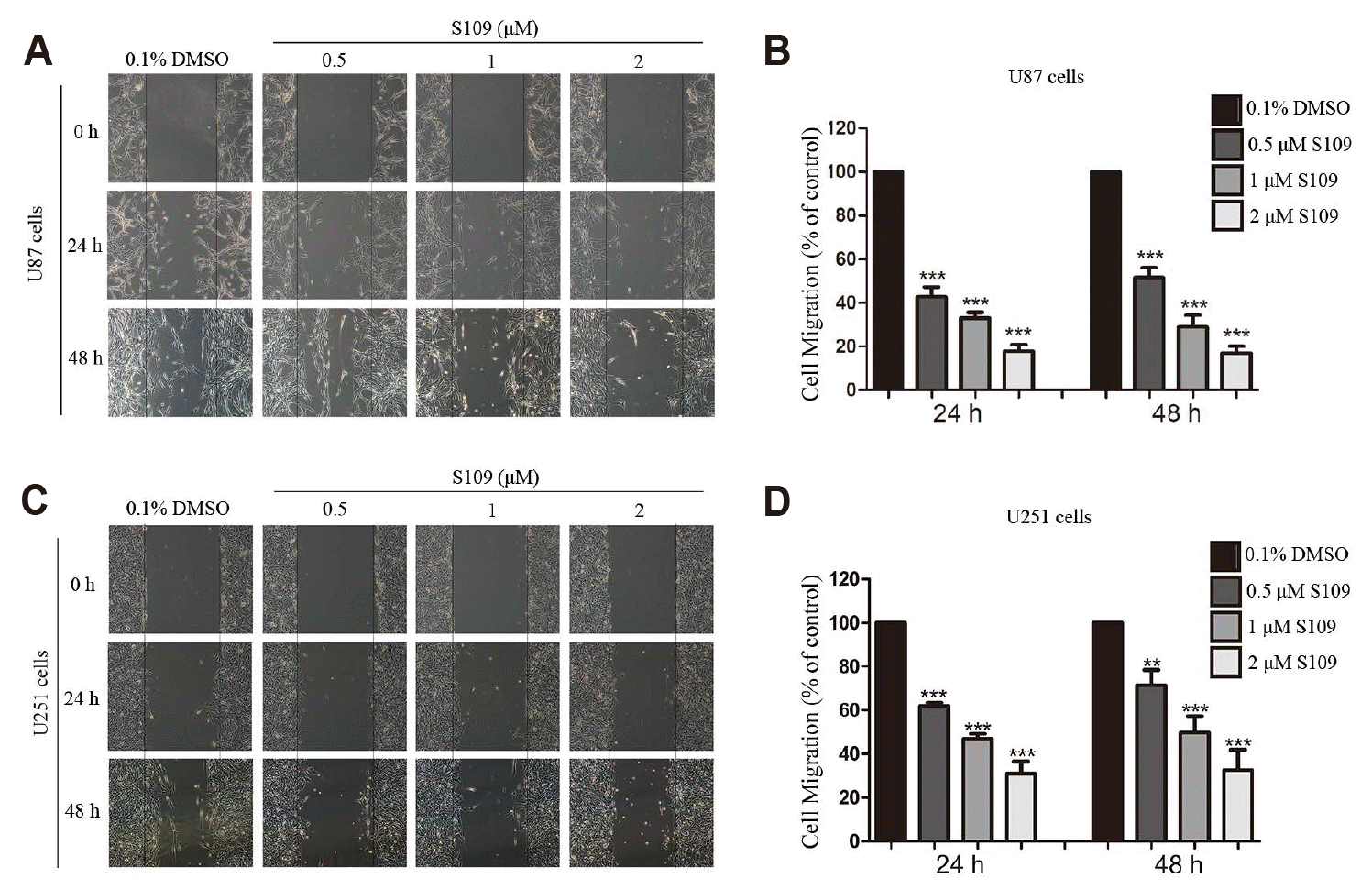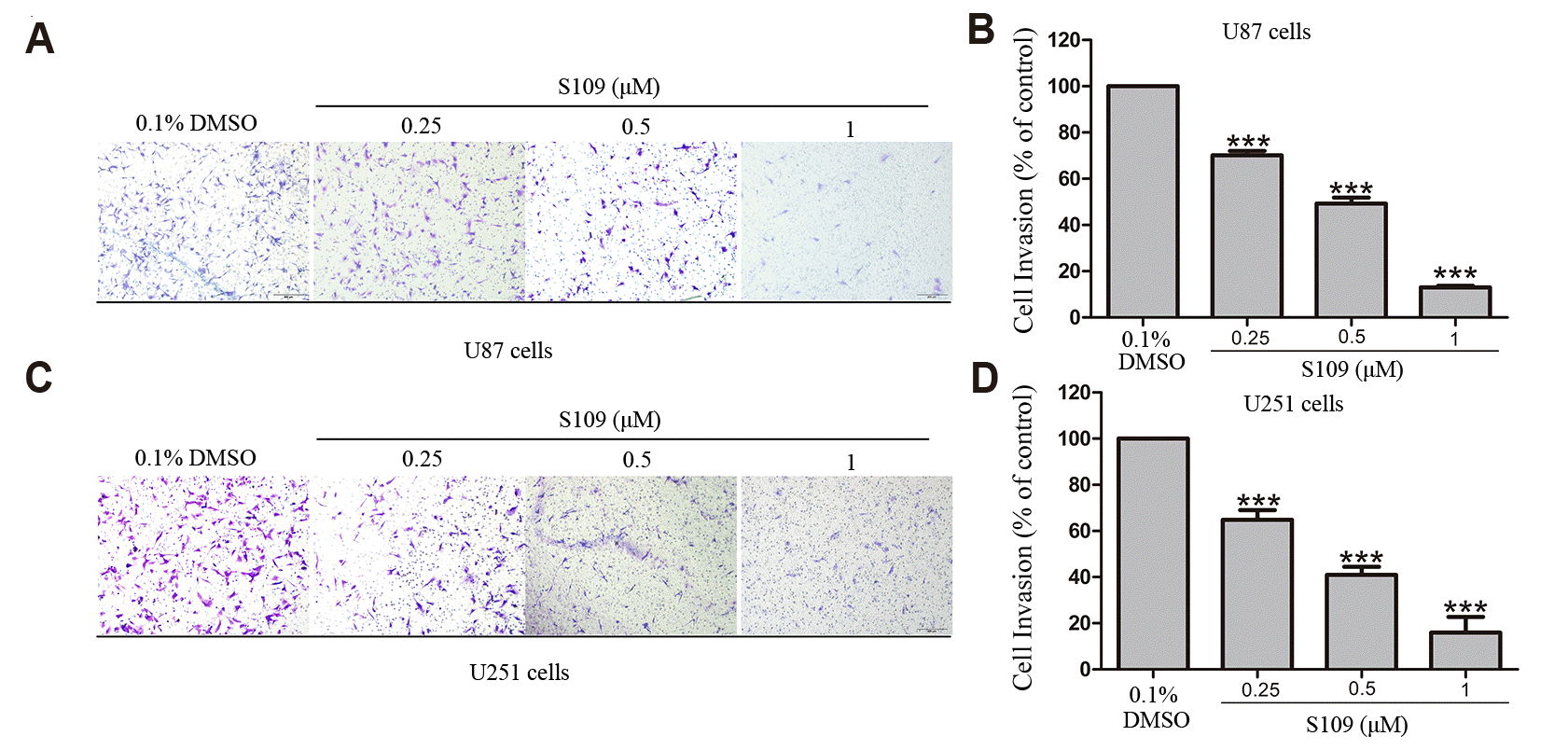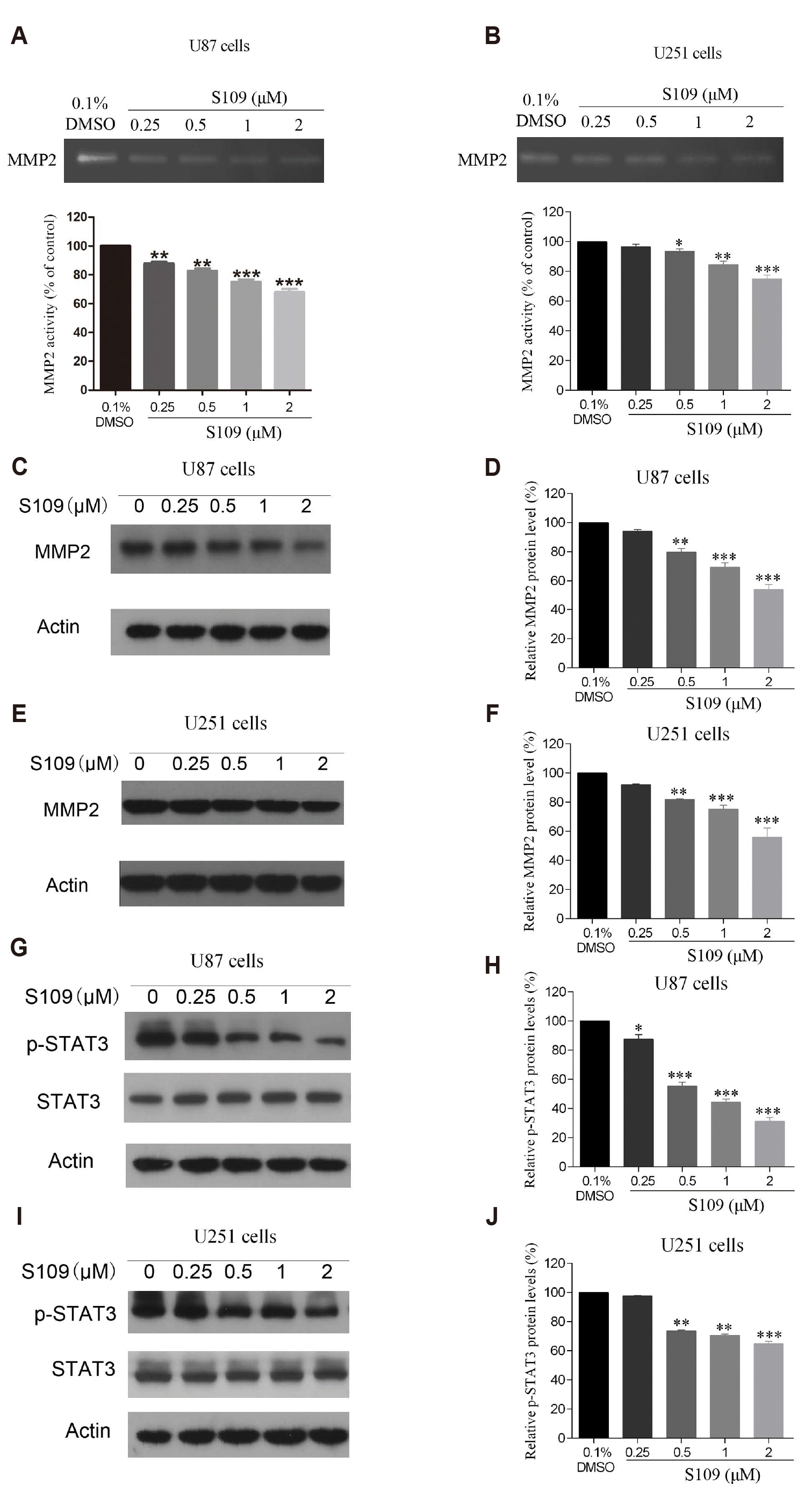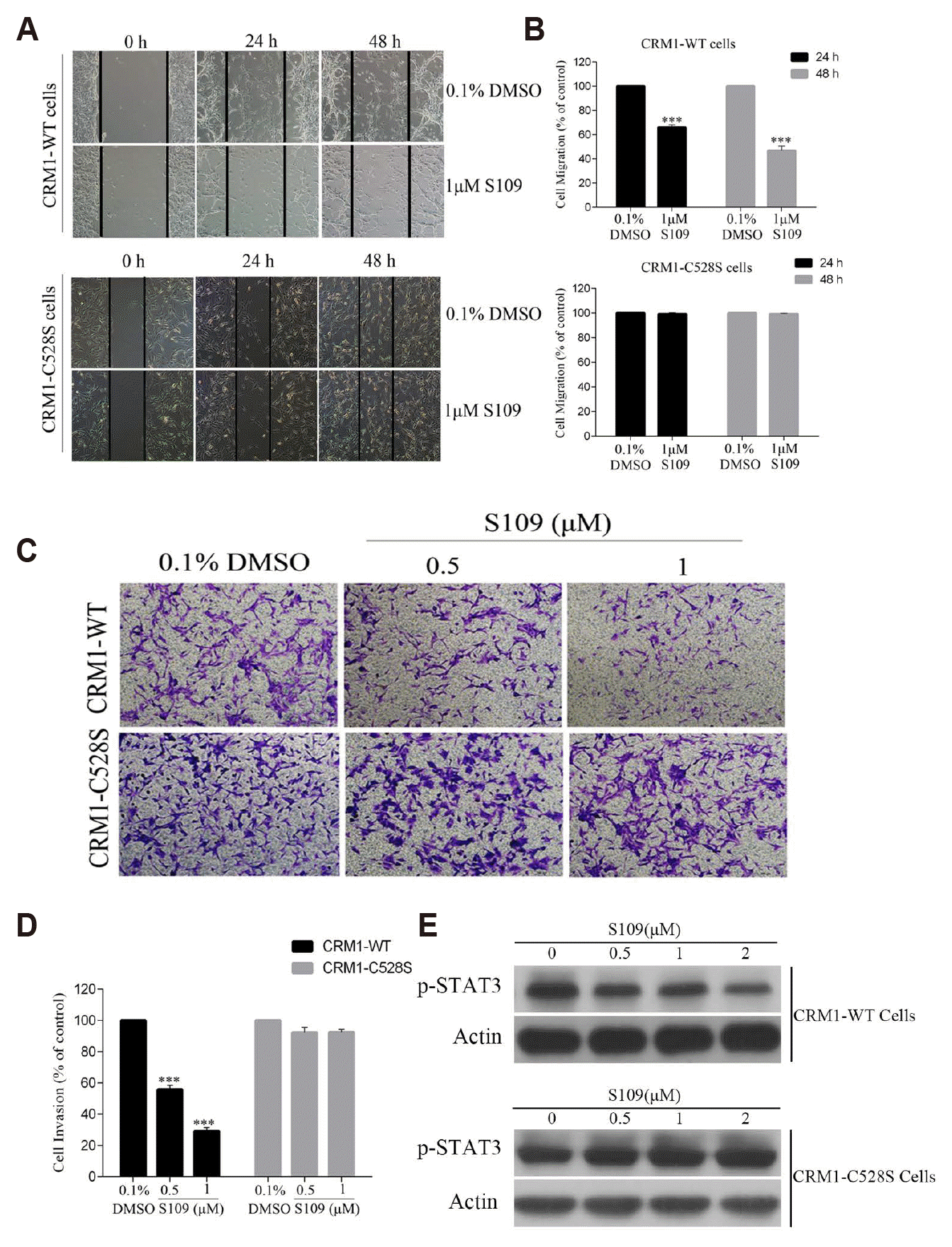1. Piromkraipak P, Sangpairoj K, Tirakotai W, Chaithirayanon K, Unchern S, Supavilai P, Power C, Vivithanaporn P. 2018; Cysteinyl leukotriene receptor antagonists inhibit migration, invasion, and expression of MMP-2/9 in human glioblastoma. Cell Mol Neurobiol. 38:559–573. DOI:
10.1007/s10571-017-0507-z. PMID:
28600709.

2. Mu N, Gu J, Liu N, Xue X, Shu Z, Zhang K, Huang T, Chu C, Zhang W, Gong L, Zhao H, Jia B, Gao D, Shang L, Zhang W, Guo Q. 2018; PRL-3 is a potential glioblastoma prognostic marker and promotes glioblastoma progression by enhancing MMP7 through the ERK and JNK pathways. Theranostics. 8:1527–1539. DOI:
10.7150/thno.22699. PMID:
29556339. PMCID:
PMC5858165.

3. Liu YP, Dong FX, Chai X, Zhu S, Zhang BL, Gao DS. 2016; Role of autophagy in capsaicin-induced apoptosis in U251 glioma cells. Cell Mol Neurobiol. 36:737–743. DOI:
10.1007/s10571-015-0254-y. PMID:
26351174.

4. Zhang BL, Liu J, Lei Y, Xiong Y, Li H, Lin X, Yao RQ, Gao DS. 2016; An epigenetic mechanism of high gdnf transcription in glioma cells revealed by specific sequence methylation. Mol Neurobiol. 53:4352–4362. DOI:
10.1007/s12035-015-9365-1. PMID:
26232065.

5. García-Santisteban I, Arregi I, Alonso-Mariño M, Urbaneja MA, Garcia-Vallejo JJ, Bañuelos S, Rodríguez JA. 2016; A cellular reporter to evaluate CRM1 nuclear export activity: functional analysis of the cancer-related mutant E571K. Cell Mol Life Sci. 73:4685–4699. DOI:
10.1007/s00018-016-2292-0. PMID:
27312238.

6. Noske A, Weichert W, Niesporek S, Röske A, Buckendahl AC, Koch I, Sehouli J, Dietel M, Denkert C. 2008; Expression of the nuclear export protein chromosomal region maintenance/exportin 1/Xpo1 is a prognostic factor in human ovarian cancer. Cancer. 112:1733–1743. DOI:
10.1002/cncr.23354. PMID:
18306389.

7. Tajiri N, De La Peña I, Acosta SA, Kaneko Y, Tamir S, Landesman Y, Carlson R, Shacham S, Borlongan CV. 2016; A nuclear attack on traumatic brain injury: sequestration of cell death in the nucleus. CNS Neurosci Ther. 22:306–315. DOI:
10.1111/cns.12501. PMID:
26842647. PMCID:
PMC5067638.

8. Wang H, Ding Z, Shi QM, Ge X, Wang HX, Li MX, Chen G, Wang Q, Ju Q, Zhang JP, Zhang MR, Xu LC. 2017; Anti-androgenic mechanisms of Bisphenol A involve androgen receptor signaling pathway. Toxicology. 387:10–16. DOI:
10.1016/j.tox.2017.06.007. PMID:
28645579.

9. Zhou F, Chen E, You D, Song Y, Sun Z, Yue L. 2016; Both high expression of nucleophosmin/B23 and CRM1 predicts poorer prognosis in human gastric cancer. APMIS. 124:1046–1053. DOI:
10.1111/apm.12604. PMID:
27714846.

10. Li C, Yang D, Cao X, Wang F, Jiang H, Guo H, Du L, Guo Q, Yin X. 2016; LFG-500, a newly synthesized flavonoid, attenuates lipopolysaccharide-induced acute lung injury and inflammation in mice. Biochem Pharmacol. 113:57–69. DOI:
10.1016/j.bcp.2016.05.007. PMID:
27206337.

11. Yao Y, Dong Y, Lin F, Zhao H, Shen Z, Chen P, Sun YJ, Tang LN, Zheng SE. 2009; The expression of CRM1 is associated with prognosis in human osteosarcoma. Oncol Rep. 21:229–235. DOI:
10.3892/or_00000213. PMID:
19082467.

12. Liu X, Chong Y, Tu Y, Liu N, Yue C, Qi Z, Liu H, Yao Y, Liu H, Gao S, Niu M, Yu R. 2016; CRM1/XPO1 is associated with clinical outcome in glioma and represents a therapeutic target by perturbing multiple core pathways. J Hematol Oncol. 9:108. DOI:
10.1186/s13045-016-0338-2. PMID:
27733172. PMCID:
PMC5059893.

13. Yang X, Cheng L, Yao L, Ren H, Zhang S, Min X, Chen X, Zhang J, Li M. 2014; Involvement of chromosome region maintenance 1 (CRM1) in the formation and progression of esophageal squamous cell carcinoma. Med Oncol. 31:155. DOI:
10.1007/s12032-014-0155-9. PMID:
25148895.

15. Turner JG, Dawson J, Cubitt CL, Baz R, Sullivan DM. 2014; Inhibition of CRM1-dependent nuclear export sensitizes malignant cells to cytotoxic and targeted agents. Semin Cancer Biol. 27:62–73. DOI:
10.1016/j.semcancer.2014.03.001. PMID:
24631834. PMCID:
PMC4108511.

16. Paulus A, Ailawadhi S, Chanan-Khan A. 2016; Novel therapeutic targets in Waldenstrom macroglobulinemia. Best Pract Res Clin Haematol. 29:216–228. DOI:
10.1016/j.beha.2016.08.020. PMID:
27825468.

17. Fathi N, Rashidi G, Khodadadi A, Shahi S, Sharifi S. 2018; STAT3 and apoptosis challenges in cancer. Int J Biol Macromol. 117:993–1001. DOI:
10.1016/j.ijbiomac.2018.05.121. PMID:
29782972.

18. Jiang C, Xu Q, Xu K, Dai H, Zhang Z, Wu W, Ni J. 2013; Effects of erythropoietin on STAT1 and STAT3 levels following cerebral ischemia-reperfusion in rats. Int J Neurosci. 123:684–690. DOI:
10.3109/00207454.2013.817409. PMID:
23786492.

19. Zheng T, Hong X, Wang J, Pei T, Liang Y, Yin D, Song R, Song X, Lu Z, Qi S, Liu J, Sun B, Xie C, Pan S, Li Y, Luo X, Li S, Fang X, Bhatta N, Jiang H, et al. 2014; Gankyrin promotes tumor growth and metastasis through activation of IL-6/STAT3 signaling in human cholangiocarcinoma. Hepatology. 59:935–946. DOI:
10.1002/hep.26705. PMID:
24037855.

20. De Simone V, Franzè E, Ronchetti G, Colantoni A, Fantini MC, Di Fusco D, Sica GS, Sileri P, MacDonald TT, Pallone F, Monteleone G, Stolfi C. 2015; Th17-type cytokines, IL-6 and TNF-α synergistically activate STAT3 and NF-kB to promote colorectal cancer cell growth. Oncogene. 34:3493–3503. DOI:
10.1038/onc.2014.286. PMID:
25174402. PMCID:
PMC4493653.

21. Wang YC, Zheng LH, Ma BA, Zhou Y, Zhang MH, Zhang DZ, Fan QY. 2011; Clinical value of signal transducers and activators of transcription 3 (STAT3) gene expression in human osteosarcoma. Acta Histochem. 113:402–408. DOI:
10.1016/j.acthis.2010.03.002. PMID:
20546860.

22. Zhao C, Li H, Lin HJ, Yang S, Lin J, Liang G. 2016; Feedback activation of STAT3 as a cancer drug-resistance mechanism. Trends Pharmacol Sci. 37:47–61. DOI:
10.1016/j.tips.2015.10.001. PMID:
26576830.

23. Senft C, Priester M, Polacin M, Schröder K, Seifert V, Kögel D, Weissenberger J. 2011; Inhibition of the JAK-2/STAT3 signaling pathway impedes the migratory and invasive potential of human glioblastoma cells. J Neurooncol. 101:393–403. DOI:
10.1007/s11060-010-0273-y. PMID:
20589525.

24. Nusblat LM, Carroll MJ, Roth CM. 2017; Crosstalk between M2 macrophages and glioma stem cells. Cell Oncol (Dordr). 40:471–482. DOI:
10.1007/s13402-017-0337-5. PMID:
28643230.

25. Liu X, Chen X, Shi L, Shan Q, Cao Q, Yue C, Li H, Li S, Wang J, Gao S, Niu M, Yu R. 2019; The third-generation EGFR inhibitor AZD9291 overcomes primary resistance by continuously blocking ERK signaling in glioblastoma. J Exp Clin Cancer Res. 38:219. DOI:
10.1186/s13046-019-1235-7. PMID:
31122294. PMCID:
PMC6533774.

26. Han ZX, Wang XX, Zhang SN, Wu JX, Qian HY, Wen YY, Tian H, Pei DS, Zheng JN. 2014; Downregulation of PAK5 inhibits glioma cell migration and invasion potentially through the PAK5-Egr1-MMP2 signaling pathway. Brain Tumor Pathol. 31:234–241. DOI:
10.1007/s10014-013-0161-1. PMID:
24062079.

27. Fan YC, Mei PJ, Chen C, Miao FA, Zhang H, Li ZL. 2013; MiR-29c inhibits glioma cell proliferation, migration, invasion and angiogenesis. J Neurooncol. 115:179–188. DOI:
10.1007/s11060-013-1223-2. PMID:
23943502.

28. Mei PJ, Bai J, Miao FA, Li ZL, Chen C, Zheng JN, Fan YC. 2019; Relationship between expression of XRCC1 and tumor proliferation, migration, invasion, and angiogenesis in glioma. Invest New Drugs. 37:646–657. DOI:
10.1007/s10637-018-0667-9. PMID:
30328556.

29. Yue C, Niu M, Shan QQ, Zhou T, Tu Y, Xie P, Hua L, Yu R, Liu X. 2017; High expression of Bruton's tyrosine kinase (BTK) is required for EGFR-induced NF-κB activation and predicts poor prognosis in human glioma. J Exp Clin Cancer Res. 36:132. DOI:
10.1186/s13046-017-0600-7. PMID:
28946903. PMCID:
PMC5613332.

30. Teng DC, Sun J, An YQ, Hu ZH, Liu P, Ma YC, Han B, Shi Y. 2016; Role of PHLPP1 in inflammation response: Its loss contributes to gliomas development and progression. Int Immunopharmacol. 34:229–234. DOI:
10.1016/j.intimp.2016.02.034. PMID:
26971226.

31. Liu F, Zhao X, Qian Y, Zhang J, Zhang Y, Yin R. 2017; MiR-206 inhibits Head and neck squamous cell carcinoma cell progression by targeting HDAC6 via PTEN/AKT/mTOR pathway. Biomed Pharmacother. 96:229–237. DOI:
10.1016/j.biopha.2017.08.145. PMID:
28987947.

32. Falk P, Jonsson A, Swartling T, Asplund D, Ivarsson ML. 2018; Role of matrix metalloproteinases in tumour invasion: immunohistochemistry of peritoneum from peritoneal carcinomatosis. Med Oncol. 35:64. DOI:
10.1007/s12032-018-1122-7. PMID:
29623449. PMCID:
PMC5886990.

33. Yang Q, Wang WW, Ma P, Ma ZX, Hao M, Adelusi TI, Lei-Du , Yin XX, Lu Q. 2017; Swimming training alleviated insulin resistance through Wnt3a/β-catenin signaling in type 2 diabetic rats. Iran J Basic Med Sci. 20:1220–1226. DOI:
10.22038/IJBMS.2017.9473. PMID:
29299199. PMCID:
PMC5749356.
34. Chen F, Xu Y, Luo Y, Zheng D, Song Y, Yu K, Li H, Zhang L, Zhong W, Ji Y. 2010; Down-regulation of Stat3 decreases invasion activity and induces apoptosis of human glioma cells. J Mol Neurosci. 40:353–359. DOI:
10.1007/s12031-009-9323-3. PMID:
20069389.

35. Cho HJ, Park JH, Nam JH, Chang YC, Park B, Hoe HS. 2018; Ascochlorin suppresses MMP-2-mediated migration and invasion by targeting FAK and JAK-STAT signaling cascades. J Cell Biochem. 119:300–313. DOI:
10.1002/jcb.26179. PMID:
28569433.

36. Sun Q, Carrasco YP, Hu Y, Guo X, Mirzaei H, Macmillan J, Chook YM. 2013; Nuclear export inhibition through covalent conjugation and hydrolysis of Leptomycin B by CRM1. Proc Natl Acad Sci U S A. 110:1303–1308. DOI:
10.1073/pnas.1217203110. PMID:
23297231. PMCID:
PMC3557022.

37. Lu DY, Yeh WL, Huang SM, Tang CH, Lin HY, Chou SJ. 2012; Osteopontin increases heme oxygenase-1 expression and subsequently induces cell migration and invasion in glioma cells. Neuro Oncol. 14:1367–1378. DOI:
10.1093/neuonc/nos262. PMID:
23074199. PMCID:
PMC3480271.

38. Ishizawa J, Kojima K, Hail N Jr, Tabe Y, Andreeff M. 2015; Expression, function, and targeting of the nuclear exporter chromosome region maintenance 1 (CRM1) protein. Pharmacol Ther. 153:25–35. DOI:
10.1016/j.pharmthera.2015.06.001. PMID:
26048327. PMCID:
PMC4526315.

39. Sakakibara K, Saito N, Sato T, Suzuki A, Hasegawa Y, Friedman JM, Kufe DW, Vonhoff DD, Iwami T, Kawabe T. 2011; CBS9106 is a novel reversible oral CRM1 inhibitor with CRM1 degrading activity. Blood. 118:3922–3931. DOI:
10.1182/blood-2011-01-333138. PMID:
21841164.

40. Li WX, Yang MX, Hong XQ, Dong TG, Yi T, Lin SL, Qin XY, Niu WX. 2016; Overexpression of gelsolin reduces the proliferation and invasion of colon carcinoma cells. Mol Med Rep. 14:3059–3065. DOI:
10.3892/mmr.2016.5652. PMID:
27573444. PMCID:
PMC5042772.

41. Friedl P, Alexander S. 2011; Cancer invasion and the microenvironment: plasticity and reciprocity. Cell. 147:992–1009. DOI:
10.1016/j.cell.2011.11.016. PMID:
22118458.

42. Panth KM, van den Beucken T, Biemans R, Lieuwes NG, Weber M, Losen M, Yaromina A, Dubois LJ, Lambin P. 2016; In vivo optical imaging of MMP2 immuno protein antibody: tumor uptake is associated with MMP2 activity. Sci Rep. 6:22198. DOI:
10.1038/srep22198. PMID:
26923459. PMCID:
PMC4770595.

43. Yu Q, Shen W, Zhou H, Dong W, Gao D. 2016; Knockdown of LI-cadherin alters expression of matrix metalloproteinase-2 and -9 and galectin-3. Mol Med Rep. 13:4469–4474. DOI:
10.3892/mmr.2016.5069. PMID:
27035870.

44. Gravina GL, Tortoreto M, Mancini A, Addis A, Di Cesare E, Lenzi A, Landesman Y, McCauley D, Kauffman M, Shacham S, Zaffaroni N, Festuccia C. 2014; XPO1/CRM1-selective inhibitors of nuclear export (SINE) reduce tumor spreading and improve overall survival in preclinical models of prostate cancer (PCa). J Hematol Oncol. 7:46. DOI:
10.1186/1756-8722-7-46. PMID:
25284315. PMCID:
PMC4283114.

45. Yu H, Kortylewski M, Pardoll D. 2007; Crosstalk between cancer and immune cells: role of STAT3 in the tumour microenvironment. Nat Rev Immunol. 7:41–51. DOI:
10.1038/nri1995. PMID:
17186030.

46. Sato N, Tsuruma R, Imoto S, Sekine Y, Muromoto R, Sugiyama K, Matsuda T. 2005; Nuclear retention of STAT3 through the coiled-coil domain regulates its activity. Biochem Biophys Res Commun. 336:617–624. DOI:
10.1016/j.bbrc.2005.08.145. PMID:
16140268.

47. Ou Y, Liu L, Xue L, Zhou W, Zhao Z, Xu B, Song Y, Zhan Q. 2014; TRAP1 shows clinical significance and promotes cellular migration and invasion through STAT3/MMP2 pathway in human esophageal squamous cell cancer. J Genet Genomics. 41:529–537. DOI:
10.1016/j.jgg.2014.08.004. PMID:
25438697.

48. Herrmann A, Vogt M, Mönnigmann M, Clahsen T, Sommer U, Haan S, Poli V, Heinrich PC, Müller-Newen G. 2007; Nucleocytoplasmic shuttling of persistently activated STAT3. J Cell Sci. 120(Pt 18):3249–3261. DOI:
10.1242/jcs.03482. PMID:
17726064.

50. Shao WY, Yang YL, Yan H, Huang Q, Liu KJ, Zhang S. 2017; Phenethyl isothiocyanate suppresses the metastasis of ovarian cancer associated with the inhibition of CRM1-mediated nuclear export and mTOR-STAT3 pathway. Cancer Biol Ther. 18:26–35. DOI:
10.1080/15384047.2016.1264540. PMID:
27981892. PMCID:
PMC5323014.

51. Cheng Y, Holloway MP, Nguyen K, McCauley D, Landesman Y, Kauffman MG, Shacham S, Altura RA. 2014; XPO1 (CRM1) inhibition represses STAT3 activation to drive a survivin-dependent oncogenic switch in triple-negative breast cancer. Mol Cancer Ther. 13:675–686. DOI:
10.1158/1535-7163.MCT-13-0416. PMID:
24431073. PMCID:
PMC3954411.

52. Xie TX, Wei D, Liu M, Gao AC, Ali-Osman F, Sawaya R, Huang S. 2004; Stat3 activation regulates the expression of matrix metalloproteinase-2 and tumor invasion and metastasis. Oncogene. 23:3550–3560. DOI:
10.1038/sj.onc.1207383. PMID:
15116091.









 PDF
PDF Citation
Citation Print
Print


 XML Download
XML Download